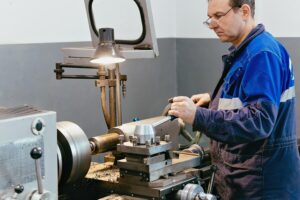Master the Art of Aligning Lathe Centers for Precision Turning. Our guide reveals expert techniques and tips to perfect lathe Center alignment for flawless turning projects.
How to Aligning Lathe Centers: A Step-by-Step Guide

Making sure that the lathe centres are correctly aligned is one of the essential components that cannot be ignored when it comes to precision machining on a lathe. For your turning tasks to be accurate and reliable, lathe Center alignment is essential. This thorough guide will coach you through the necessary procedures and methods for successfully aligning lathe Centers.
Setting Up the Lathe:
Step 1: Mounting the Lathe on the Floor
Before you start aligning the lathe Centers, it’s essential to ensure that the lathe is securely mounted on the floor. A stable foundation is crucial for the precision work that lathes perform.
Step 2: Leveling the Lathe
The first key step in aligning lathe Centers is leveling the lathe bed. This ensures that the lathes’ bed is flat and not twisted. Small lathes may be supported at one point, while larger ones, like a Myford, might be supported at two points or even more. To achieve this:
Use a level capable of detecting a difference of 0.1 mm in 1 meter for smaller lathes.
If your lathe bed has inverted V-shapes for guiding the saddle and tail stock, place parallels or equal-thickness objects on either side and use the level on top to check for flatness.
Remember that adjusting one bolt can impact the others, making the process iterative. Keep adjusting until the bed is level in both directions.
Adjusting the Bearings:
The spindle bearings play a critical role in the lathe’s performance. Follow these steps to ensure they are properly adjusted:
- Locate the pair of nuts on the left side of the headstock for spindle bearing adjustment.
- Adjust the right nut to eliminate radial and axial play in the spindle while ensuring smooth rotational movement.
- After adjustment, lock the nut to the left and double-check the spindle’s condition for play and smooth rotation.
Aligning the Headstock
For precise turning, the axis of the spindle must be parallel to the lathe bed. Here’s how to align the headstock:
- If your lathe allows for adjustment, ensure the spindle’s axis is parallel to the bed.
- Use a test bar with a taper to check the alignment. The test bar should show zero runout when touched with a DTI (Dial Test Indicator).
Aligning the Tailstock
To align the tailstock accurately, follow these steps:
- Assuming your headstock is parallel to the bed and the spindle Center is coaxial with the spindle, use a test bar.
- Place the test bar between the Center in the spindle and the center in the tail stock.
- Use a DTI to check the edge of the test bar along its length.
Creating a Tool for Alignment

Now that you’ve learned how to align the lathe Centers, it’s helpful to have a tool for this purpose. Here’s what you’ll need:
Materials for Creating the Alignment Tool
Gauge: A dial or digital gauge.
- Steel Bar: You’ll require a length of steel bar for the tool. The diameter is not overly critical as long as it offers rigidity. It’s recommended to have a minimum diameter of 25mm (1″). The length should closely match the size of the workpieces you intend to machine. Having extra length is beneficial, as you can store any excess inside the headstock spindle.
- Mounting Bar: Obtain a 10mm (3/8″) steel bar. Its length should be sufficient to securely mount your chosen gauge by your preferred method. Ensure the bar is straight and free of bends or warping for accurate alignment. Deburr the ends of the bar to allow smooth and secure seating in the lathe centres.
- Lathe Dead Center: You’ll need a lathe dead center with a Morse taper that matches your tailstock (e.g., MT2). Make sure the center is clean and free of rust or damage before use. A properly fitted dead center ensures stability and precision during alignment.
- Grub Screw: A 6mm (1/4″) diameter grub screw. It should be long enough to hold the gauge securely without protruding excessively. Make sure the threads match the tapped hole in your mounting setup for a tight and reliable fit.
Tools Required for Crafting the Alignment Tool
- Lathe: Access to a lathe is essential for machining the alignment tool. The lathe allows you to turn the steel bar accurately and ensure concentricity. Precision in this step is critical, as even slight misalignment can affect the reliability of your measurements.
- Drill Press or Hole-Making Equipment: A drill press or suitable equipment for creating holes in the materials. Accurate drilling ensures proper alignment and a secure fit for components. Use a sharp bit and clamp the workpiece firmly to avoid drifting or uneven holes.
- Thread Tap (Optional): If needed for your specific gauge support design, you may require a thread tap that matches the grub screw. This ensures the screw threads smoothly into the hole with a secure fit. Always use cutting fluid when tapping to reduce friction and prevent damage to the threads.
- Welder (Optional): This is only necessary if you opt for a welded gauge support method. Welding provides a strong and permanent connection, ideal for heavy-duty or long-term use. However, it requires proper safety precautions and access to appropriate welding equipment.
Conclusion
Aligning lathe Centers is a fundamental aspect of precision machining. By following the steps outlined in this guide and having the right tools at your disposal, you can ensure that your lathe Centers are properly aligned, leading to accurate and high-quality turning results.
FAQ’s
What makes aligning lathe centers so important?
For precision machining and error-free turning projects, aligning lathe centers guarantees that the workpiece rotates precisely along the lathe’s axis.
Am I able to align lathe centers without using specialized equipment?
A dial indicator and test bars are specialist instruments that can substantially ease alignment and improve accuracy; however, some alignment can be done manually.
How frequently should I realign and inspect the lathe centers?
Particularly after moving the lathe or if you observe decreased machining precision, regular checks and realignments are advised. Depending on usage, maintenance plans may change, but a proactive approach yields the best results over time.




